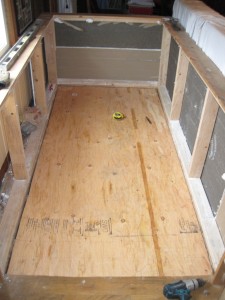After all the adventures in plumbing, the next project in the queue was taking out the crappy stairs down to the basement. For reference, here’s a photo of the stairs:
Step 1: Knocked down the existing stairs. Pretty easy work with a hammer and a prybar. I really did this simultaneously with step 2, since it was easiest to install most of the joists while sitting on the stairs, but the last two had to be after taking out the stairs and lifted over my head. (Have I mentioned that I have biceps for the first time in my life?)
Step 2: Sister the cut joists with fresh 2x8s. I had to use pressure-treated wood since there is no sill plate on top of the foundation and the joists would be resting directly on concrete. And since I didn’t trust pure sistering, I cut them long enough to sit on the girder in the middle of the room. I followed Mike Holmes’ advice and glued and screwed them to the existing joists and toe-screwed them into the rim joist. This is where having the One Drill To Rule Them All really came in handy.


Step 3: Put down the subfloor. This step is a little out of order since I had to get it done before the in-laws showed up that evening; I would have rather done all the blocking first. I forgot to use adhesive on the joists, so I doubled up the screws to 6″ apart throughout.
Step 4: Take out the half walls around the edge. Easier said than done, because although each wall had only about three studs in it and could be wobbled by hand about an inch either way, they were put together with a really excessive number of 3″ screws.
Step 5: Insulate the rim joist using doubled-up pieces cut out of a 2″ thick Foamular 250 board for a total of R-20, and seal the edges with expanding foam. I made sure to take photos of every joist bay to prove to the inspector that I insulated, since you wouldn’t be able to see it after the next step.
Step 6: Install blocking around the edge of the subfloor patch to support the edges. Because of where the main water pipe runs under the old top of the stairs I couldn’t maneuver in notched 2×8 blocking, so I put in 2x6s against the subfloor and then cut and hammered in 1″-2″ pieces of the pressure-treated board to fill between the 2×6 and the foundation. It’s a little squishier than the rest of the patched area but well within tolerance.
Step 7: Cut a piece of birch plywood to act as a finish floor until we can afford to have the hardwood patched in and refinished by a contractor. I tried really hard to get an exact fit — I taped paper over the patch and marked the edge of the hole by crayon rubbing, and then cut out the template and transferred it to the plywood — but since I don’t have a jigsaw and it’s really rather difficult to match a wandering line with a circular saw, the patch is off by up to half an inch. Sigh.
Step 8: Rearrange furniture to suit.
And that’s where it stands today. There’s still a whole bunch of debris in the basement I haven’t lugged out to the ever-growing junk pile. And I’d like to stain the plywood “oak” color to match the rest of the floor, but I am stain-illiterate and I’m worried I’d make a huge mess for a crappy result.
Eventually, I’m going to build a new set of stairs where the old front entry/current walk-in closet is, but that’s going to require a hell of a lot of structural work, with steel posts and concrete saws and LVL beams and so on, not to mention lots of exacting finish carpentry. I have a good book on the subject, and I have a Google Sketchup model about halfway completed, but it’ll still be after next year’s tax return before I can even think of taking it on.





#1 by Jennifer on October 1, 2010 - 9:04 am
Quote
We so need the’Mike says make it right’ cross stitch for our house.
#2 by moses on October 1, 2010 - 9:57 am
Quote
Cross stitch? Send me picture of what you want and I can do it (and happily)!
#3 by Bryan on October 8, 2010 - 11:00 am
Quote
Awesome! Sending you an email right now. Thanks!
#4 by Shakespeare on October 2, 2010 - 7:01 pm
Quote
Just a silly question, since I seemed to have missed it, but how do you get into the basement now?
#5 by Bryan on October 4, 2010 - 9:10 am
Quote
The exterior basement access stairs, which used to be hidden under a layer of plywood.